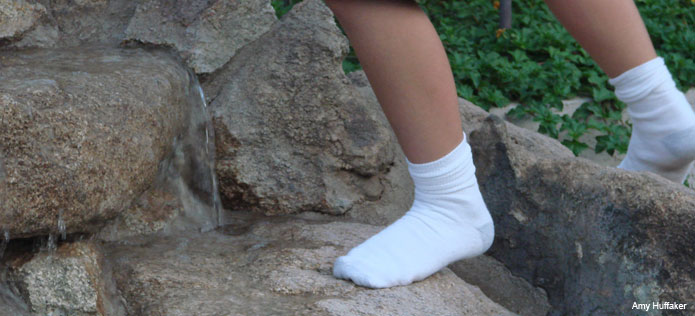
Explore how seeds can travel and plant themselves.
What You Need
- Access to an area overgrown with grass and weeds
- 9 x 13-inch baking pan
- Brick or similar size block
- Plant mister filled with water
- 1 pair of long, old, white cotton socks
- Potting soil (enough to fill the socks)
What You Do
- Take a Walk
Pull the socks over your child’s shoes and pant legs. Take a walk in a vacant lot, park, or other area overgrown with grass and weeds. (Watch out for ticks if they live in your area.) - Fill Socks With Soil
After your walk, pull off the socks. Look carefully at the seeds your child has collected on the socks, but do not remove the seeds.
Fill the socks with damp potting soil. - Put Socks in Baking Pan
Spray the socks with the plant mister and lay them in the baking pan. Prop a brick or large block under one end of the pan so the pan is tilting. At the lower end of the pan, add enough water so the ends of the socks can soak up the water and be completely wet.
Put the pan in a warm, sunny place. - Mist Socks
During the next 10 days, continue to put enough water in the lower end of the pan to keep the socks wet. Mist the socks every other day with water. - Talk About Your Results
After approximately 10 days, plants should sprout from the socks. Begin a discussion with your child about these results by saying that seeds need to move to new places so they can grow into plants. Add that there are many ways seeds travel to new places.- How did the seeds travel to the socks? (They stuck to the socks.)
- What else might seeds stick to? (Animals’ fur, feathers, or feet)
- How do these “sticky seeds” plant themselves? (They fall off or get picked off and end up in soil.)
- Seeds travel in other ways too. How do most dandelion seeds travel? Hint: What happens when you blow on a fluffy white dandelion head? (The wind carries away the seeds.)
- Some palm trees produce coconuts. Coconuts are the largest seeds in the world. Sometimes people find coconuts on beaches that have no palm trees. How do you think these large seeds got on the beach? (The ocean probably carried them.)
For older children: You might want to include these points in your discussion.
- Some seeds are eaten when an animal eats fruit. Later the seeds come out with the animal’s droppings.
- Some seeds have little wings that help them twirl through the air (e.g., maple seeds).
- An acorn is a seed. Squirrels pick up acorns, carry them to new places, and bury them. If an animal doesn’t dig up one of these acorns later, the acorn might grow into an oak tree one day.

